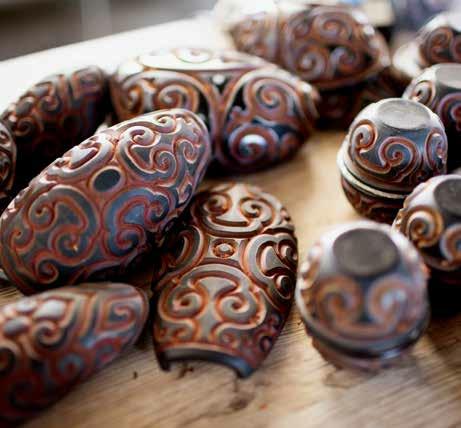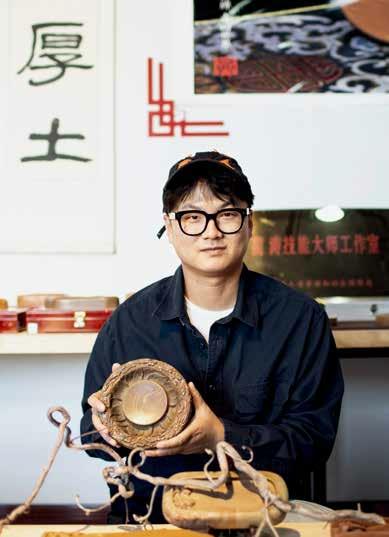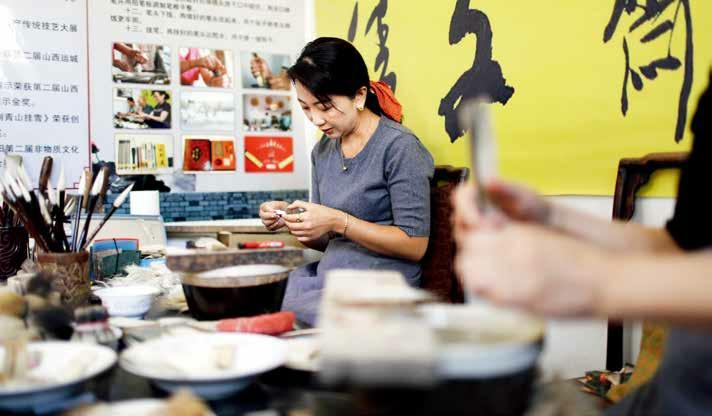Cutting-edge Traditions
2020-02-04byGongHaiying
by Gong Haiying



On the morning of September 19, 2020, the autumn air was fresh, and only a few wisps of white clouds roamed the vast blue sky. In the square in front of the Lord Guan Temple Scenic Area in Yuncheng, northern Chinas Shanxi Province, a burst of vigorous ancient drum music rang out, kindling excitement among tourists. The drum music stopped abruptly, and a whistle rang out, cueing two athletes in Chinese wrestling suits to clasp fists and bow before the match. A few minutes later, the match came to an end, and one wrestler was declared the winner. Again, they saluted each other before leaving the wrestling ring.
The match was part of the 7th Shanxi Wrestling Championship in Yuncheng and the 10th “Wu Sheng Cup” Wrestling Championship. Only a few years ago, the competition began to revive Chinese-style wrestling from a bottleneck hindering its development. This is regarded as an“innovation in cultural carriers by combining Lord Guan culture with the new era.”
The inclusiveness of traditional Chinese culture and Yunchengs efforts to restore and enrich the vitality and cohesion of cultural heritage are clear in this drive. This ancient land, regarded by many as a cradle of Chinese civilization, is home to a wealth of precious Chinese cultural legacies preserving thousands of years of history. Important issues facing Yuncheng include devising methods to wade through the challenges of the times, writing a glorious chapter for the new era, and ensuring the cultural memories of the Chinese nation remain engraved in its genes forever.
Crystalizing Salt Culture Tourism
Yuncheng is not only well-known as the hometown of Guan Yu, an ancient general who has been deified as Lord Guan, but also attracts tourists from all over the world as the only city established for salt production in China.
At 8 a.m. on September 18, an old off-road vehicle loaded with six passengers set off toward the salt lake in the south suburb of Yuncheng. In less than 10 minutes, we reached the salt lake area. As the car bounced along the rugged road, no other people or vehicles were visible. Our tour guide, Chang Min, deputy chairman of the Democratic League Yuncheng Committee and vice chairman of the Yuncheng Federation of Literary and Art Circles, noted that Yuncheng stopped extracting salt there in 1986 to protect the lake. He took us to where salt was once produced.
Chang said that the Yuncheng salt lake has similar features to the Dead Sea in the Middle East. Its unique brine, black mud, and large salt crystals are very rare. Since the beginning of the 21st century, the salt lake has been transformed into a tourist resort, and visitors can experience salt water floatation and enjoy black mud baths, mineral spas and other health tourism programs, which have expanded its popularity.

The beautiful environment around the salt lake is being restored, and a cultural tourism industry focused on salt culture is emerging. Chang believes that strengthening the position of cultural tourism as a strategic pillar industry of the city requires connecting Yunchengs rich scenic spots to each other and building an integrated salt culture tourism circle involving history, sightseeing, leisure, entertainment, rehabilitation, and shopping.
In the following several days, we experienced the charm of the abundant scenic spots in Yuncheng. On September 22, the citys Wanrong County organized a sacrificial ritual at the Houtu Temple as part of the 2020 Chinese Farmers Harvest Festival. The Houtu Temple was built on a plateau on the bank of the Yellow River. Winding stone steps lead to a platform at the gate of the temple, from which the junction of the Yellow and Fenshui rivers is visible to the east. Historical records claim that the Yellow Emperor, a legendary progenitor of the Chinese nation, was the first to worship Goddess Houtu, namely Nuwa, the Chinese goddess of creation, at the site. It gradually became a key destination for emperors to offer sacrifices to the goddess. Across history, eight emperors held 24 sacrificial ceremonies there, and it is where Emperor Wu of the Han Dynasty (202 B.C.-220 A.D.) wrote the timeless poem Ode to Autumn Wind. The manuscript has been preserved in the Qiufeng Tower.
Statistics show that in 2018, the annual passenger throughput of Yuncheng Airport exceeded two million for the first time. With the accelerated development of Yuncheng, Chang Mins vision to build a salt culture tourism circle is gradually becoming a reality.
Traditional Handicrafts in Modern Life
What do traditional handmade items look like in the hands of the young generation of craftsmen? What sparks shoot out from the collision of traditional handicrafts in contemporary time? With such questions in mind, the reporter started the visit to Xinjiang County, a famous town of historical and cultural significance in China.
Tixi (literally, “Scraped Rhino Horn”) is a lacquer decoration craft. This intangible cultural heritage involves usage of a pick knife to carve patterns on the surface of lacquer ware. The varied colored lacquer layers of the knife edge section resemble the texture of the layers of cross section of a rhino horn, hence its name. Born in 1986, He Pengfei, a provincial-level inheritor of Jiangzhou Tixi in Shanxi Province, learned the handicraft from his father He Junming, the only national inheritor of Jiangzhou Tixi. A decade ago, he started systematically studying Tixi craftsmanship before gradually taking over the management of Yellow River Yundiao Craft Factory established by his father.
“One can gain new knowledge by reviewing the old,” He Pengfei said.“Innovation does not mean abandoning traditions. Only by inheriting and spreading traditional craftsmanship can we innovate.”Each year he replicates some classic lacquer works to absorb the essence that fuels his innovation. Through years of practice and extensive exchange with experts and peers from both home and abroad, He Pengfei has gradually developed his own philosophy on integrating traditional crafts with modern life.
With an aim to grasp traditional craftsmanship and merge it into modern life, inheritors of the two handicrafts of Jiangzhous Chengni inkstone and Jiwenzhai brush pen and ink seek the same innovative consciousness and spirit.
Chengni inkstone is the oldest of the four most famous inkstone genres of China and the only one made of mud. It is known for simple shape and delicate texture. The craftsmanship was lost in the late Ming Dynasty(1368-1644). Not until the 1980s did printmaking artist Lin Yongmao and his son Lin Tao in Xinjiang County resuscitate the craftsmanship that had been lost for 300 years.
Lin Zilin, born in 1990, is the thirdgeneration inheritor of Jiangzhou Chengni inkstone. He graduated from Seoul National University with a degree in ceramics. While following the traditional production methods of Chengni inkstone, he started introducing modern elements and adopting modern styles. And he developed a commitment to “making inkstones that ordinary people can afford.” He is currently trying techniques from the glass industry and metal craftsmanship, which he took as electives at university, to foster innovative production of Chengni inkstone.
The Jiwenzhai brush pen and ink store is located in Zhongcheng Lane, Xinjiang Old Street, which was once the famous“Ancient Xinjiang Brush Pen and Ink Street.” The craftsmanship of Jiwenzhais brush pen and ink has also been passed across generations. More than 20 years ago, Zhang Yongfu, founder of Jiwenzhai, passed on his pen-making skills to his daughter Zhang Xiting and his ink ingot skills to his son-in-law Wang Zhuangsheng. Zhang Xiting then passed on the penmaking and ink ingot-making skills to her son Wang Gang and daughter-in-law Zhao Sumei, who have been seeking a perfect fusion of practicality and technology to achieve extremely high practical value and artistic value at the same time.
Deeply-rooted Traditional Culture
In Sidi Village, Houcun Township, Wenxi County, couplets can be seen everywhere, inlaid on the doors of every house. Visitors may feel like entering a museum of couplets.
Couplet culture in Sidi is so ubiquitous largely because of the vigorous promotion by a group of couplet lovers in the village. In 2000, the village established the Poetry Union Association, which was later renamed the Couplet Association. Members are primarily villagers with interest in poetry, folk songs, and traditional couplet culture. Now, it has more than 100 members. In 2012, Sidi was listed among the first group of “Chinese Couplets Cultural Villages.”
Wen Shun, president of the villages Couplet Association, noted that most of the associations members are seniors over 50 years old. Every day, they gather at the villages cultural center to study, edit and match couplets while socializing with each other. He added that most of the time they squat to write couplets on the concrete floor or the lawn outside. Young people in the village are also enthusiastic about joining such activities when they revisit home on holidays from the cities where they work. The village committee often organizes summer training classes for children to promote traditional Chinese culture through instruction on calligraphy, couplets and Chinese classics.
As the sun dipped below the horizon, dimming the concrete floors of the cultural center, a pair of half-erased couplets persisted. The handwriting captured a tender voice: “The sun beyond the mountain glows, to the sea the Yellow River flows. You will find a grander sight, by climbing to a greater height.”It beckoned a three or four-year-old boy reciting Tang poetry while nestling next to his young mother. After the boy finished his recitation, his mother smiled to his seven-year-old sister next to him and said,“Your turn!”
As the last rays of light left the “land of couplets,” no words could capture the beauty of the brilliant sunset.